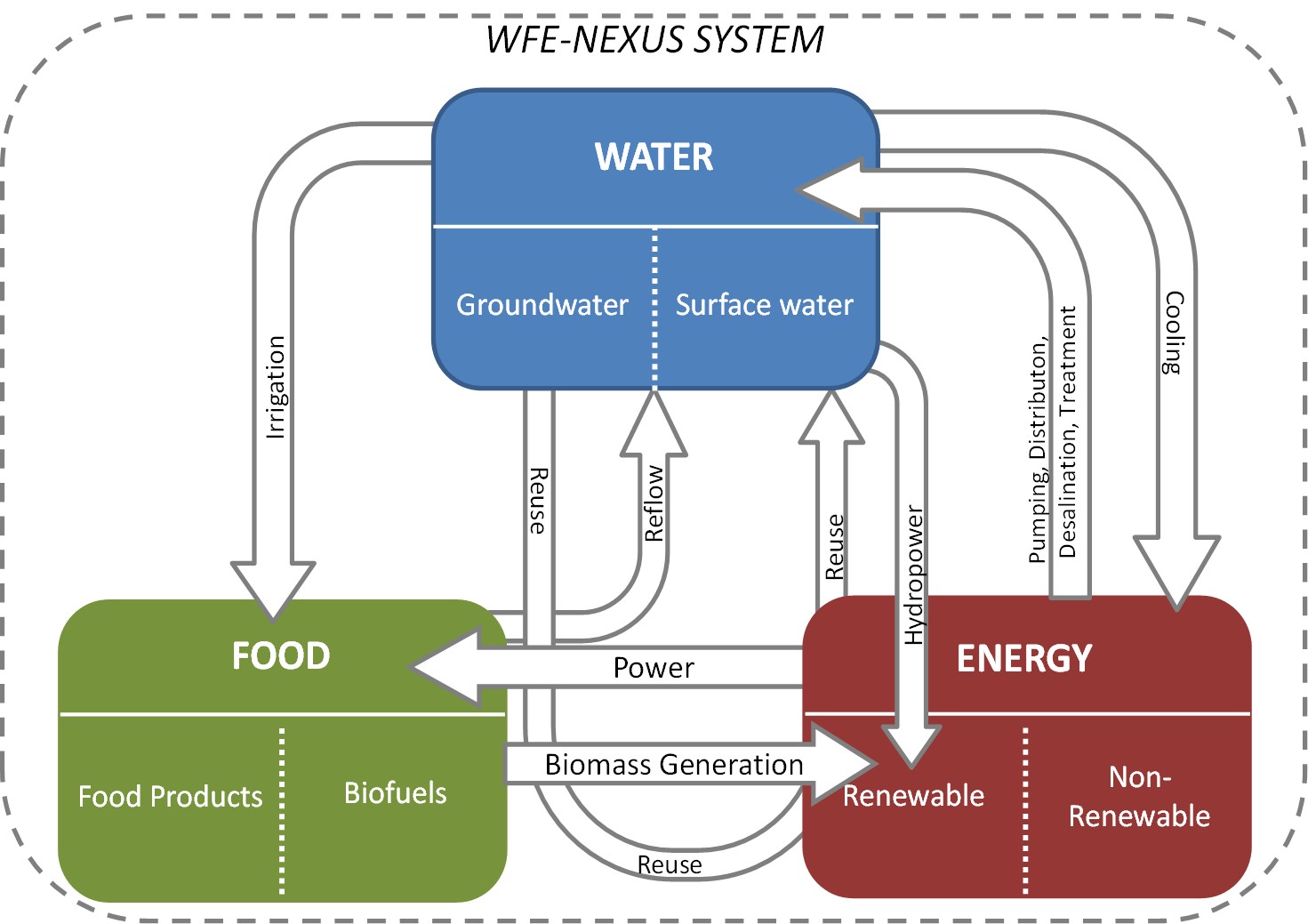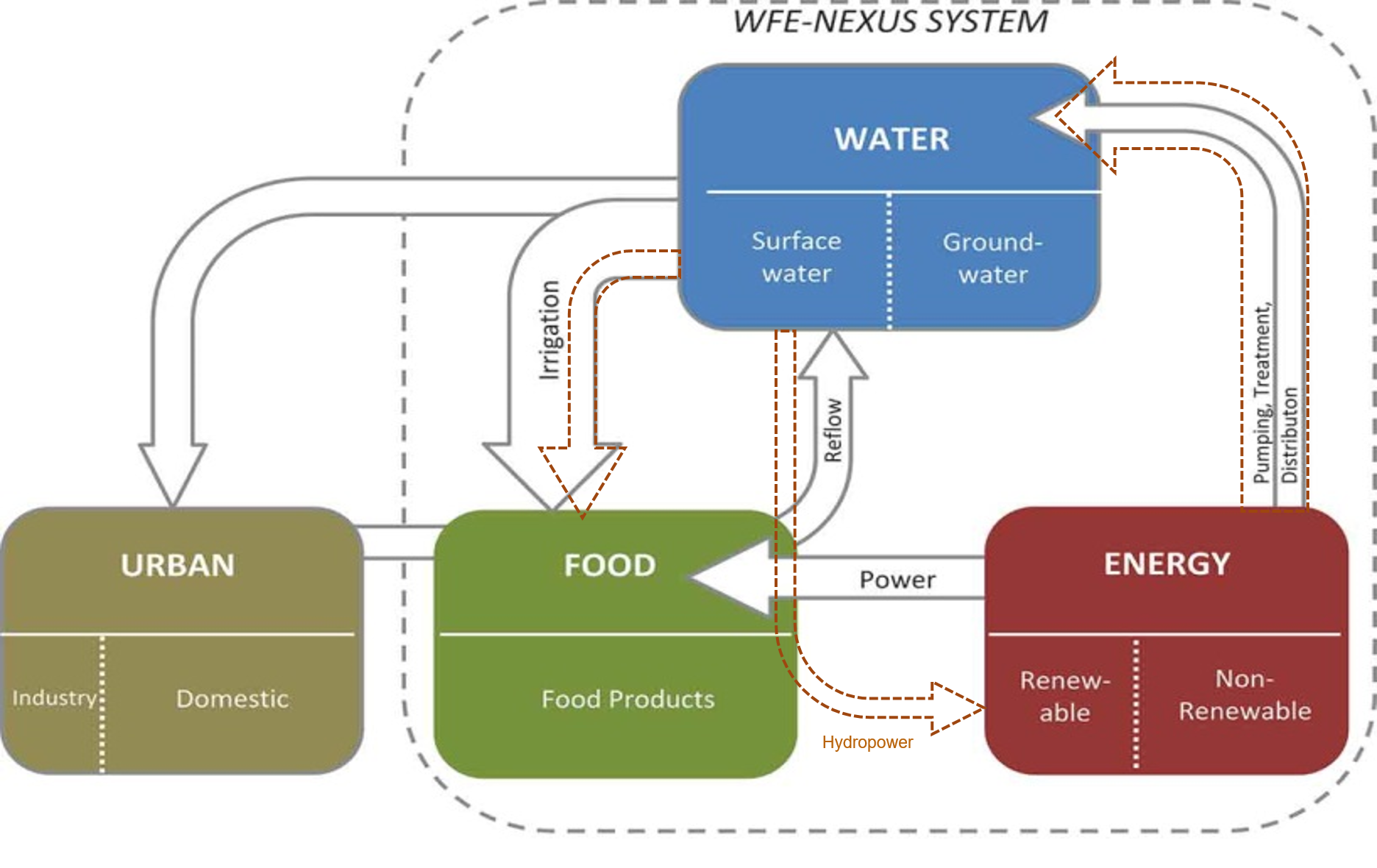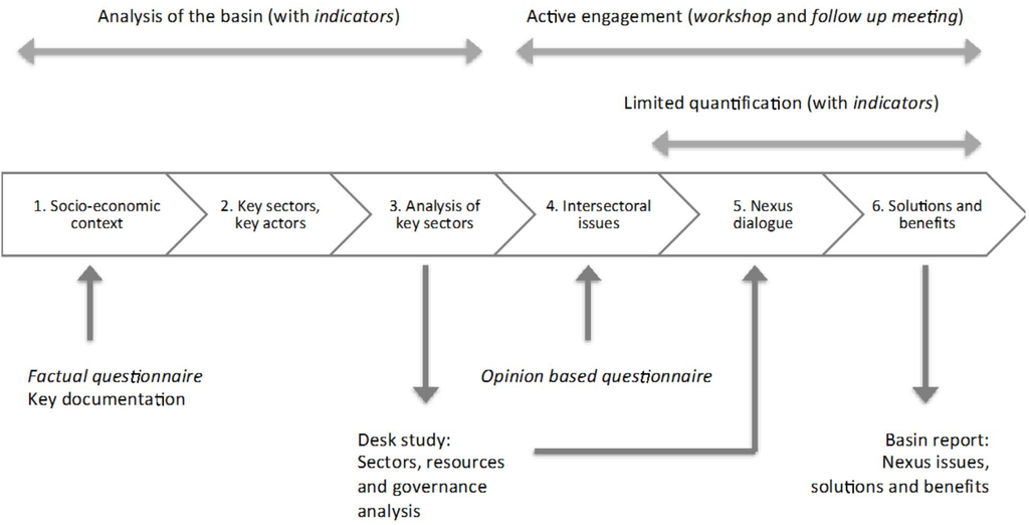5.2 Qualitative approaches to evaluate Nexus systems
5.2.1 Meza et al. (2015): Nexus System Diagram

Meza et al., 2015
Meza et al. (2015) developed a conceptual diagram to illustrate the interconnections between the different Nexus components. Systems or sectors are treated as separate units. Each compartment is divided further into sub-components (e.g. surface and groundwater; renewable and non-renewable energy sources; food products or biofuels). Global changes are connected, directly or indirectly, to each of the depicted components. This visualisation tool was developed to provide decision support at the river basin scale but can also be applied to different scales. It is a simple and straightforward method allowing to, directly or indirectly, incorporate dynamic driving forces, such as global environmental changes (as opposed to the widely used Venn diagrams).
This framework attempts to raise awareness and support stakeholder discussions thanks to its descriptive and visual representation of the Nexus. Each component is presented as a box connected by arrows representing the flows.
The size of the arrows is used to communicate magnitudes of the supply (or demand), whereas competition is represented by several arrows coming from the same source. The relative size of each subdivision and its change over time can be seen as an indicator of sensitivity of each system. A Nexus that does not change substantially under global change could be interpreted as non-vulnerable or even resilient, if adjustments over time occur without major external intervention as a driving force.
5.2.2 Example: Maipo Basin

Meza et al., 2015. Note: The arrows with dotted lines represent projected changes: either the changing thickness of an arrow or the addition of a new arrow
Meza et al. (2015) applied this concept to several river basins in Chile. Here, an example of the Nexus diagram for the Maipo Basin in central Chile is shown. Arrows indicate influence or supply/demand, and their size is indicative of their magnitude. Located within the basin is Santiago, the capital with a population of 6 million.
The region has a Mediterranean climate with mean temperatures of 20°C in summer and 10°C in winter. Mean annual precipitation is 280 mm. Snow accumulation occurs above 1,500 m altitude during winter. The main economic activities in the basin include industry, commerce and services along with an export-oriented agricultural sector.
The figure (without the arrows with dotted lines) depicts the current status of the Nexus in the basin, while the arrows with dotted lines represents the changes to the system in a future scenario with changes and pressures added to the system. For instance, more energy will be required for pumping, treating and distributing water for cities. Agriculture has to be more efficient using water in order to reduce the pressure on water resources or the potential of groundwater use needs to be explored. Also, the basin has a potential to generate hydropower. This example shows the potential of this tool to visually assess future management scenarios.
5.2.3 The Transboundary River Basin Nexus Approach (TRBNA)

de Strasser et al., 2016
The Transboundary River Basin Nexus Approach (TRBNA) was developed under the UNECE Water Convention, with the aim to inform, support and promote transboundary cooperation and to assist countries by:
- Identifying Nexus interconnections (trade-offs and impacts) across sectors and countries as well as incoherencies in governance
- Proposing actions to reduce negative impacts, minimise trade-offs and take advantage of existing complementarities and win-win opportunities.
- Providing evidence of benefits from improved cooperation at the national and transboundary levels
References
Flammini, A., Puri, M., Pluschke, L. & Dubois, O (2014), ‘Walking the Nexus Talk: Assessing the Water-Energy-Food Nexus in the Context of the Sustainable Energy for All Initiative’, Food and Agriculture Organization of the United Nations, Rome. Available at: http://www.fao.org/publications/card/en/c/f065f1d5-2dda-4df7-8df3-4defb5a098c8/
Meza, F.J., Vicuna, S., Gironás, J., Poblete, D. Suárez, F. & Oertel, M. (2015), ‘Water–food–energy nexus in Chile: the challenges due to global change in different regional contexts’, vol. 40, Nos. 5-6, pp. 839-855. doi: 10.1080/02508060.2015.1087797
De Strasser, L., Lipponen, A., Howells, M., Stec, S., Bréthaut, C. (2016), ‘A Methodology to Assess the Water Energy Food Ecosystems Nexus in Transboundary River Basins’, Water, vol. 8, Iss. 2, 59. doi:10.3390/w8020059. Download under: https://www.mdpi.com/2073-4441/8/2/59](https://www.mdpi.com/2073-4441/8/2/59"